Scorpaeniformes: Mail-Cheeked Fishes
No, you won't find any of these fishes driving a postal truck! "Mail" refers to armor, and these fishes have a spinous process extending from one of the infraorbital bones. Almost all of these fishes have spines or bony plates.
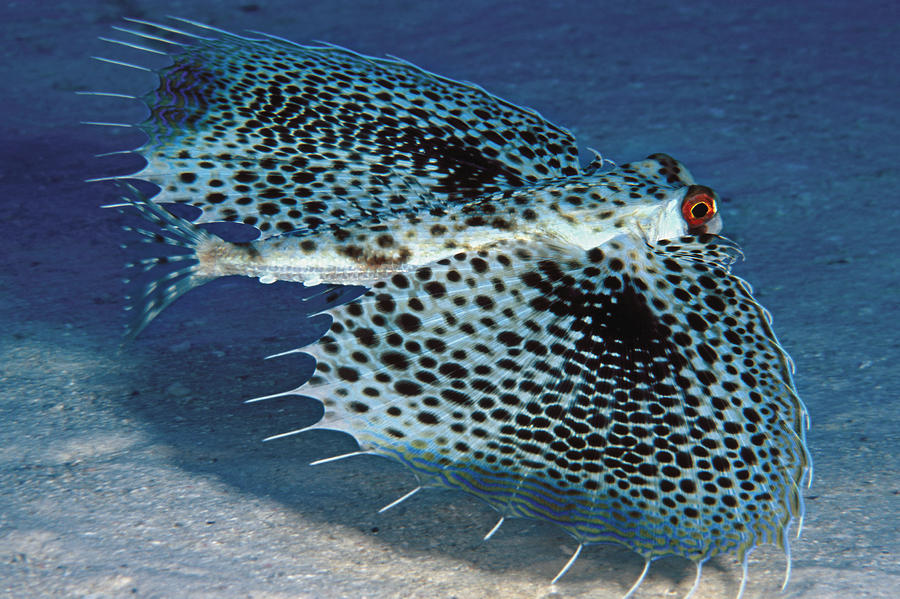
Dactylopteroidei: Flying Gurnards
There is one family, Dactylopteridae, with two genera. This family is instantly recognizable by its large, colorful pectoral fins, which can open like rounded wings (hence the common name). The head is bony, and the body is covered with scutelike scales. Although resembling sea robins (true gurnards), studies have shown that they have independently converged upon a similar body plan. They walk along the seafloor on their pelvic fins, and can produce sounds using their hyomandibula.
Scorpaenoidei
This brightly-colored suborder contains the world's most venomous fishes!
VENOMOUS VS. POISONOUS: Many people often use these words interchangably, but there's a difference between them. Impress your biology friends by knowing which is which!
POISONOUS: Poison is a toxin that is absorbed in some way through the skin, respiratory tract, or digestive system. This means breathing cyanide or drinking bleach. In the animal world, eating fugu (pufferfish) or touching a toxic salamander would be considered poisonous.
VENOMOUS: Venom is always injected. This includes heroin and other drugs. In the animal world, a rattlesnake with fangs or a scorpion with a tail would be considered venomous.
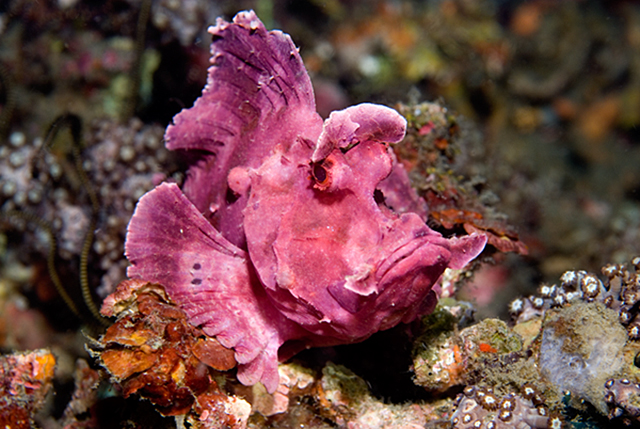
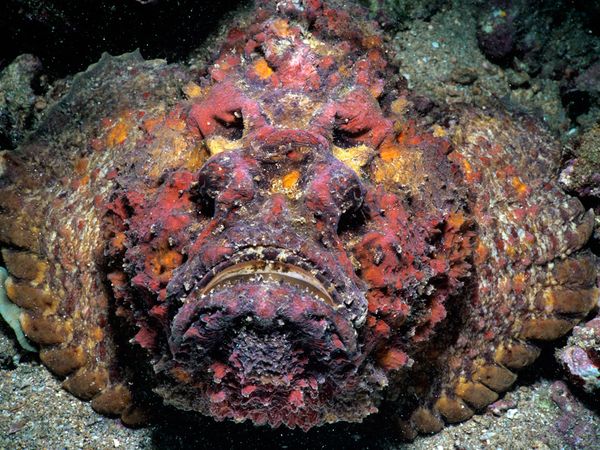
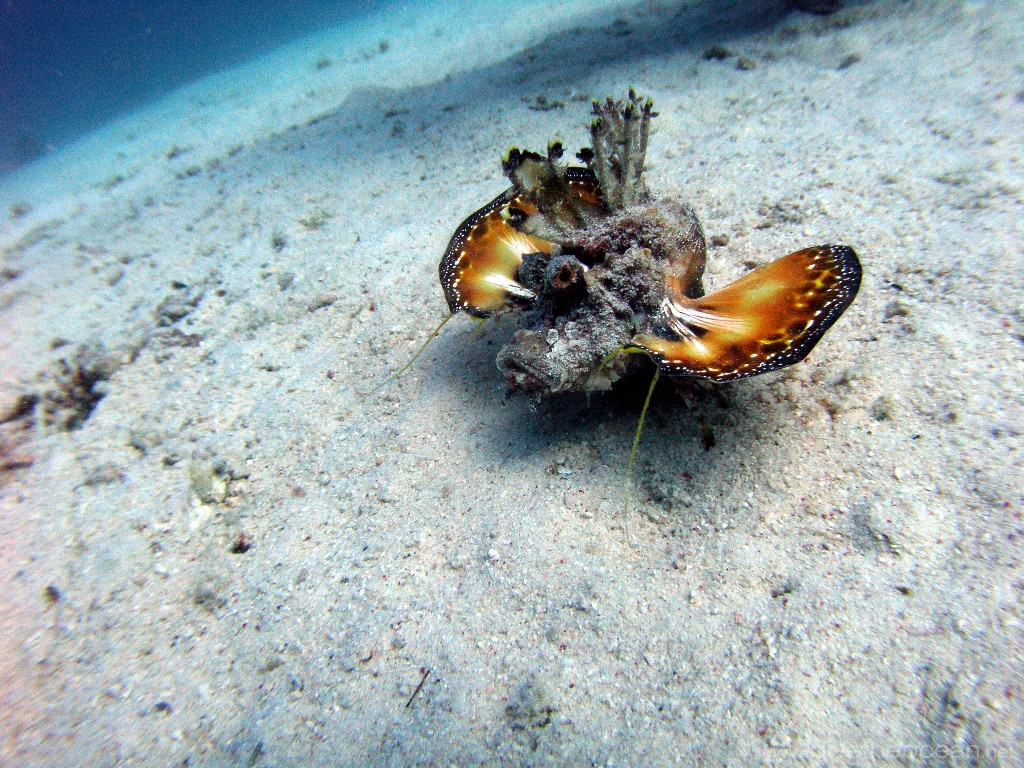
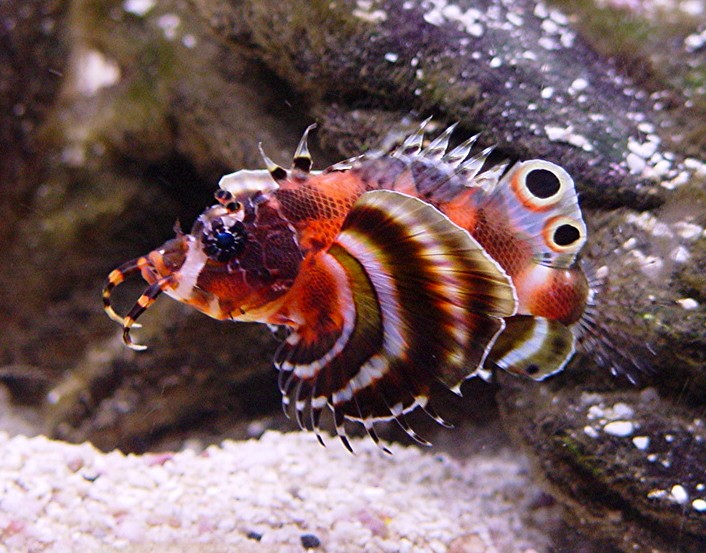
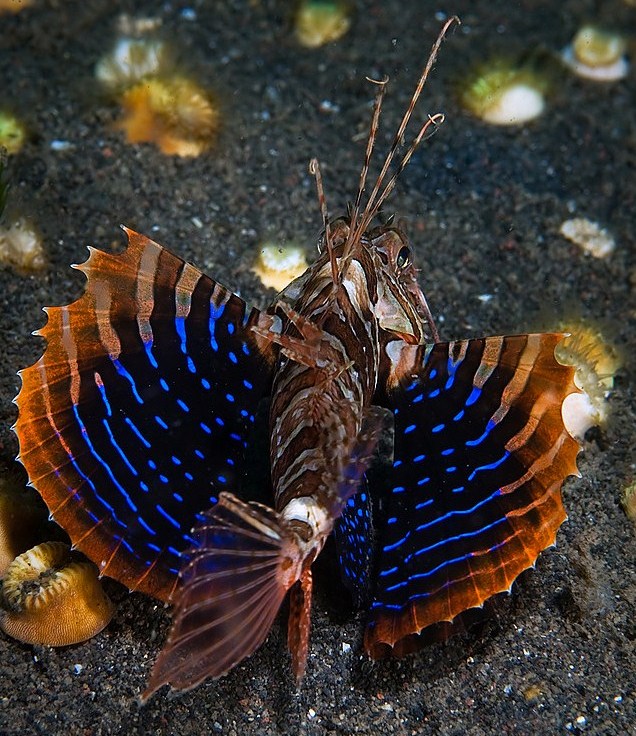
Scorpaenidae: Scorpionfishes (Rockfishes)
There are spines out the wazoo on these fishes! They have venom glands in their dorsal, pelvic, and anal fins. Many of the species use internal fertilization, and some even give birth to live young (unusual for fishes). There are often spines on the head, mainly on the operculum. Some interesting members of this family are as follows:
- Invasive Lionfishes (Pterois miles and Pterois volitans): These two species are what you usually think of as lionfish, with the extremely prominent spines and bright red-and-white colorations. They live in the Indo-Pacific, but in recent years have become an invasive species in the West Atlantic. Most likely released from private aquariums, they have multiplied due to the lack of natural predators. Many programs are in effect to capture and kill any lionfishes found in the Atlantic...supposedly they're delicious!
- Stonefish (Synanceia verrucosa): The other most famous fish in this family, the stonefish is the most venomous fish on the planet. Instead of being conspicuous like the lionfish, the stonefish blends in with the rocks and coral, remaining unnoticed until an unfortunate individual steps on it.
- Ocellated Waspfish (Apistus carinatus): And you thought wasp stings were bad...I can't tell you much about the waspfish, but it does have cool-looking pectoral fins (see picture).
- Blackfoot Firefish (Parapterois heterura): Although similar to the lionfish, this species shows its uniqueness when it opens its pectoral fins, revealing dark blue coloration with iridescent blue spots.
- Ambon Scorpionfish (Pteroidichthys amboinensis): As if they weren't bad enough already, this raggedy-looking species can change its color to provide even better camouflage!
- Eschmeyer's Scorpionfish (Rhinopias eschmeyeri): This fish looks like a strangely shaped lump of black raspberry sorbet. Look at it! LOOK!
- Devil Scorpionfish (Inimicus filamentosus): This fish looks like a pile of mud with a butterly stuck inside, sticking its wings out.
- Ocellated Lionfish (Dendrochirus biocellatus): In addition to looking like a tiny adorable lionfish, it has a curly moustache!
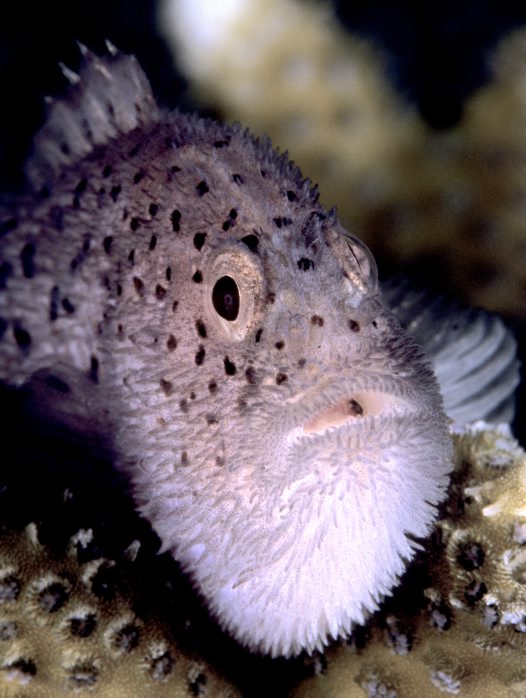
Caracanthidae: Orbicular Velvetfishes
There is one genus, Caracanthus. They have small mouths, an oval body, and are covered with small papillae that give a velvety appearance. They have extremely small pelvic fins, and a compressed body type. They are similar in body plan (except for oval shape) to the next family on the list.
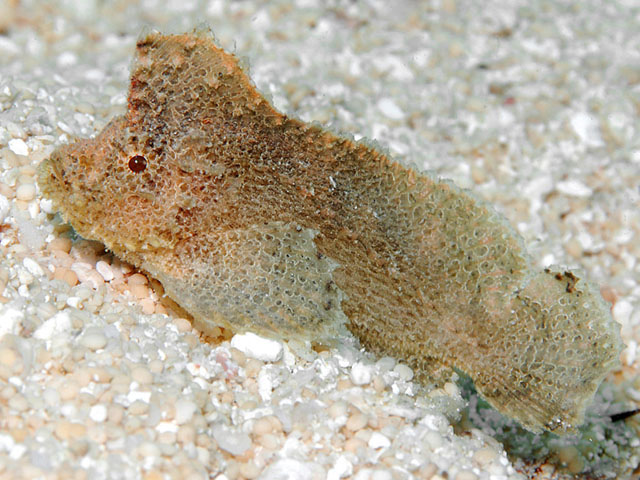
Aploactinidae: Velvetfishes
The modified scales of this family give the fishes a soft, velvety appearance. The head has knobby lumps instead of spines, and the dorsal fin begins anteriorly, sometimes in front of the eye.
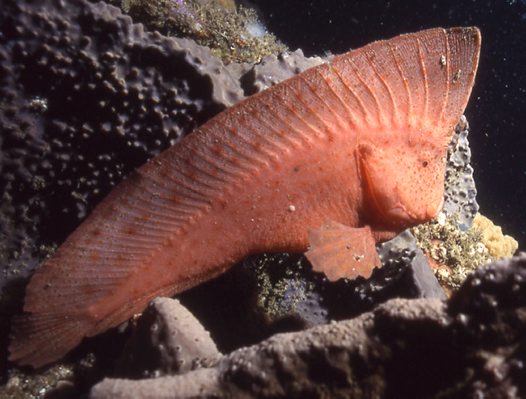
Pataecidae: Australian Prowfishes
This unusual family contains three monotypic genera. The fishes lack scales and pelvic fins, and have a dorsal fin that extends from the front of the head to the tail (sometimes connecting with the caudal fin).
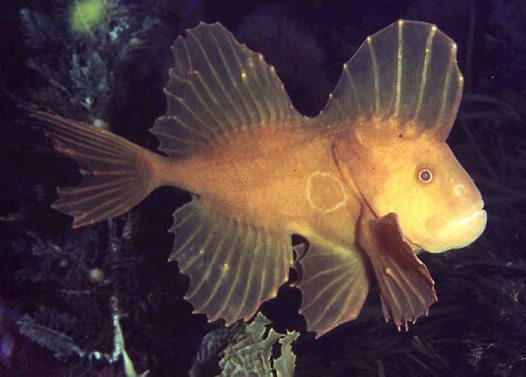
Gnathanacanthidae: Red Velvetfish
There is only one species, Gnathanacanthus goetzeei. This species has pelvic fins but lacks scales, having a velvety texture. It has two large equally-sized dorsal fins. There are opercular spines, which can cause painful wounds.
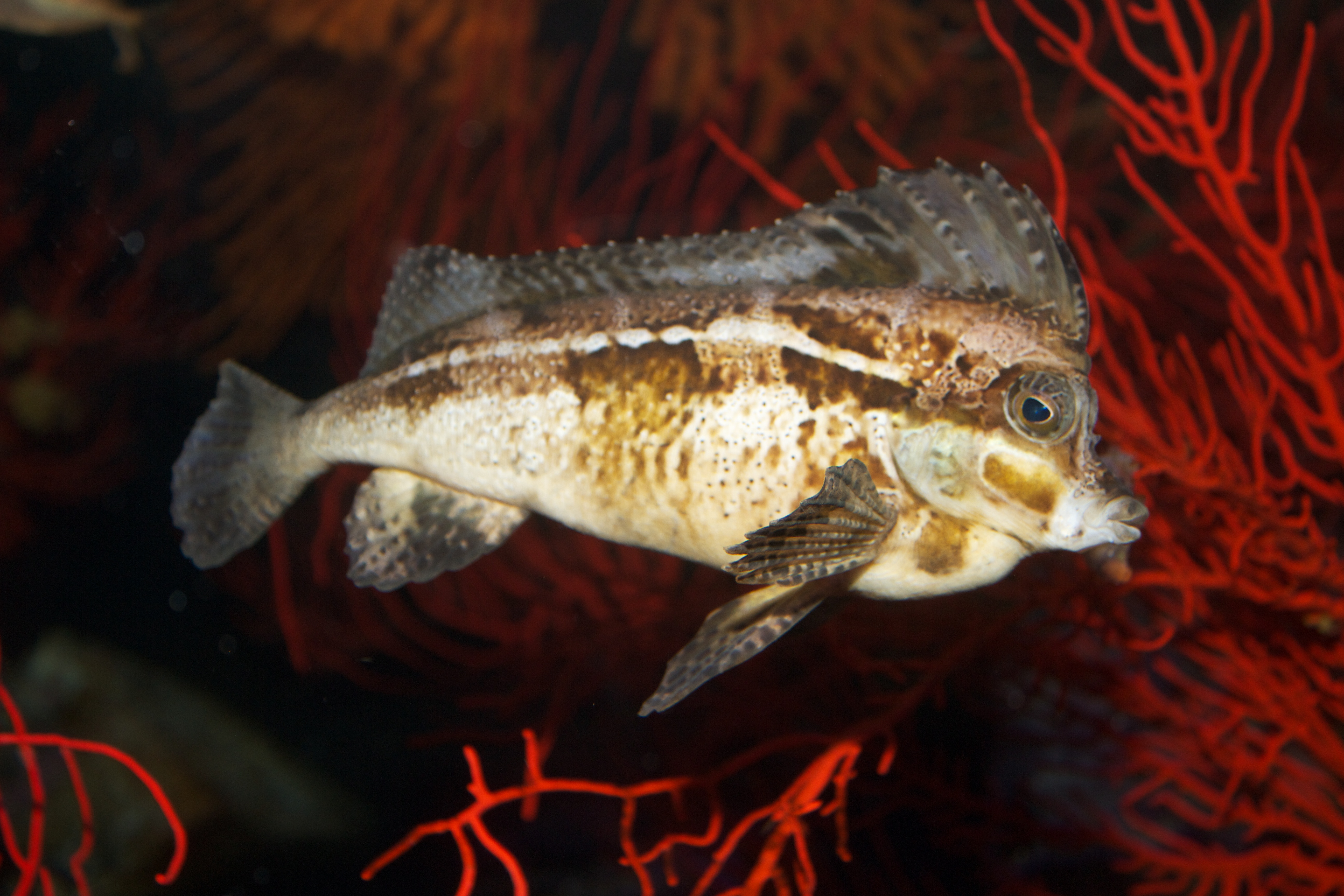
Congiopodidae: Racehorses (Pigfishes, Horsefishes)
This family has slightly pointed snouts, a dorsal fin spanning the length of the body, and lack scales.
Platycephaloidei
These fishes have elongate bodies with depressed heads and two separated dorsal fins.
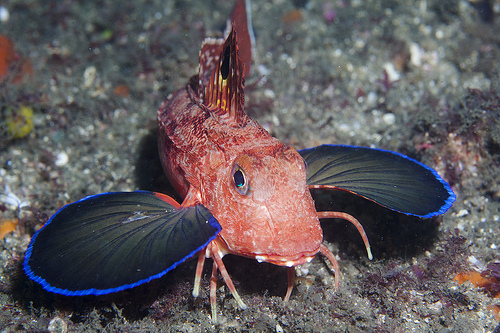
Triglidae: Searobins (Gunards)
The searobins are recognizable by their unique pectoral fins, which are able to open up like wings (similar to flying gurnards, so I guess not that unique). Even more unique are the modified rays in the pectoral fins, which are free from the fin and used to probe for food on the seafloor. These fishes get their name from the sound they make when vibrating their swimbladders, which I guess sounds like "gurnard."
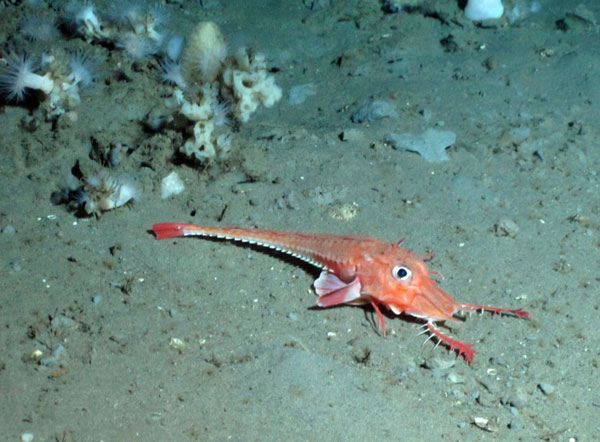
Peristediidae: Armored Searobins
Similar to searobins, they are differentiated by the obvious presence of bony plates covering their sides. The mouth is located inferiorly, and they have barbels near the mouth. The heads are also armored, and may have forward-pointing spikes or strange projections.
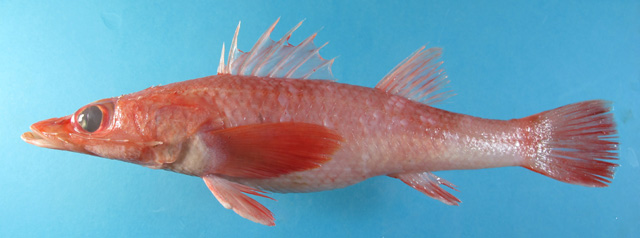
Bembridae: Deepwater Flatheads
This fishes have long skinny bodies, and are found in moderately deep water. Their heads range from slightly to strongly depressed.
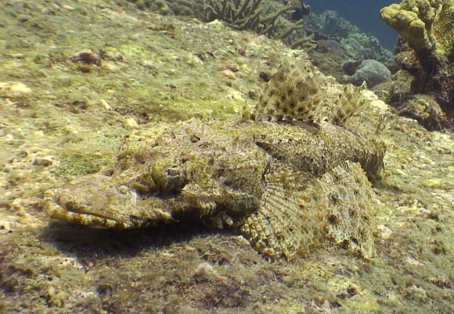
Platycephalidae: Flatheads
These fishes have extremely flat heads with eyes on top and have a first dorsal spine that is barely connected to the rest of the fin. Similar to their relatives mentioned above, they have a long skinny body shape.
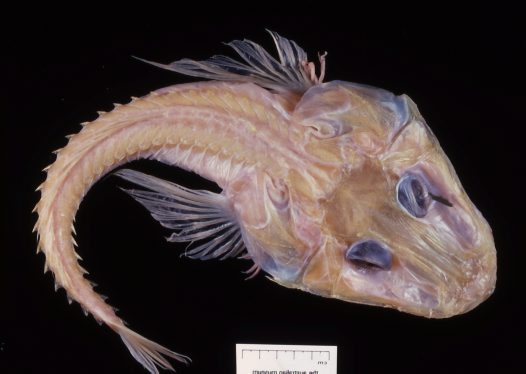
Hoplichthyidae: Ghost Flatheads
There is only one genus, Hoplichthys. These fishes have heads that are even flatter than the flatheads. How that makes them ghostly, I do not know. They lack scales but have small scutes running along the lateral line.
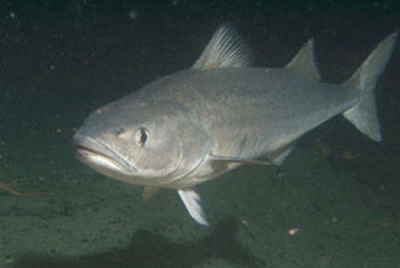
Anoplopomatoidei: Sablefishes
There is only one family, Anoplopomatidae. This family is the black sheep of the Scorpaeniformes; it can pass for a normal fish. They lack spines, ridges, or other spiky parts. They have two dorsal fins and tend to live near the bottom in deeper waters. Their most unusual characteristic is having the word "plop" in the middle of their scientific name.
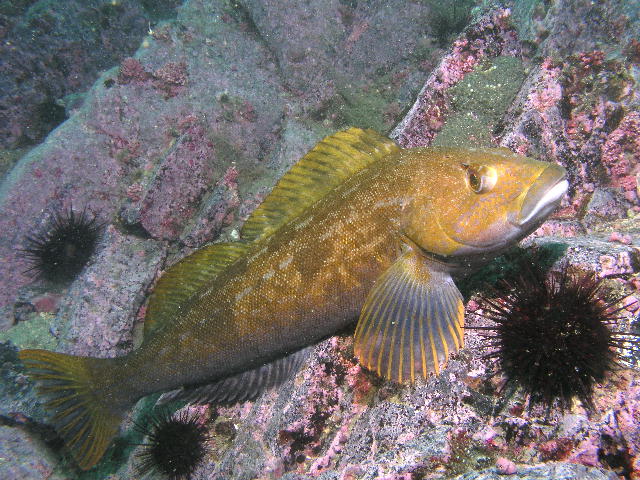
Hexagrammoidei: Greenlings
There is only one family, Hexagrammidae. These fishes may lack ridges and spines on their heads, but the do have cirri (hair-like projections). They have a single dorsal fin, with a notch between the spiny and rayed regions. They have long anal fins that lack spines. There can be one, or five, lateral lines. This family includes the food fish known as the "lingcod" (Ophiodon elongatus), which is a great name for a cod.
Normanichthyiodei: Mote Sculpin
Normanichthys crockeri, which has barely any defining characteristics, is the only species in the entire suborder. It lacks ribs, along with armor on its head. It also lacks a picture on this website, kind of like those kids in the "not pictured" section of the yearbook.
Cottoidei
What do you call a dairy product made with sculpins? Cottid cheese!
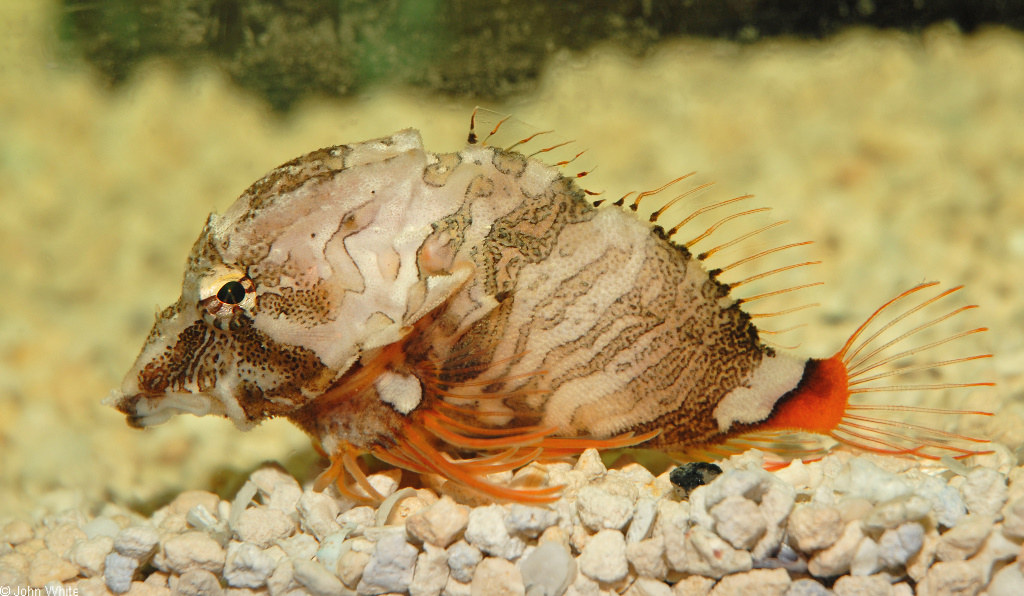
Rhamphocottidae: Grunt Sculpin
There is only one species, Rhamphocottus richardsonii. Nelson says it can be distinguished by its long head, and I'm going to trust his expertise on this one. According to the less-trustworthy Wikipedia, the female will chase the male into a hole and keep him there until he fertilizes the eggs. Scary.
Ereuniidae: Deepwater Sculpins
The defining feature of this family is that four of the pectoral fin rays are free, similar to Triglids (searobins). Whether they are used to find food or for locomotion, I cannot say.
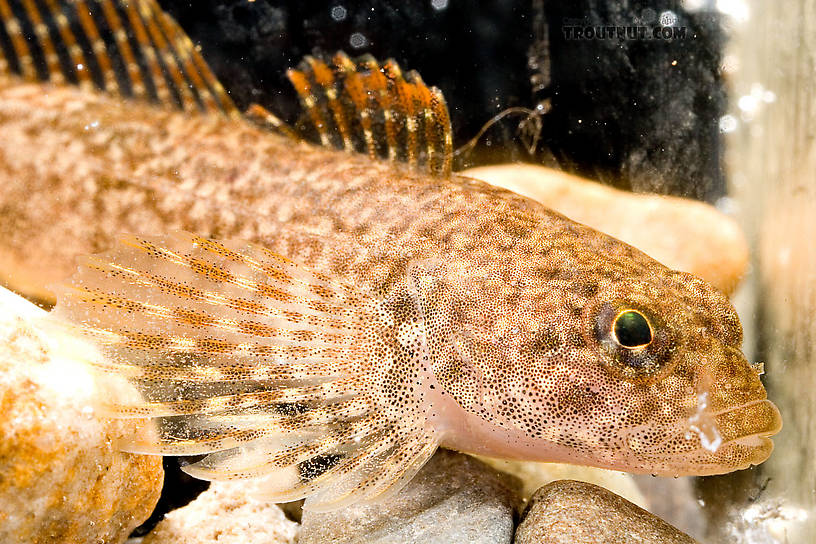
Cottidae: Sculpins
This is the largest sculpin family (over 250 species), also known as the cottids in order to discern them from the rest of the sculpins. They lack swimbladders, have large eyes, and lack anal spines. One of the genera is Cottus, not to be confused with Cottus, an evil god in the Wonder Woman comic books.
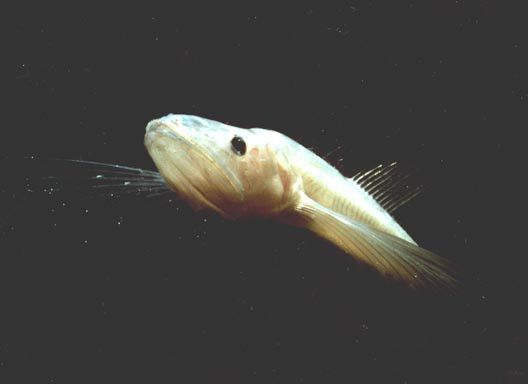
Comephoridae: Baikal Oilfishes
There is one genus, Comephorus, containing two species. These semi-transparents fishes have super long pectoral fins, but lack pelvic fins. They have a high fat content, porous bones, and large pores on the head which are part of their lateral line system. They are only found in Lake Baikal (the world's deepest freshwater lake) in Russia, and their unique adaptions allow them to move up and down in the water column without any effects due to the pressure changes.
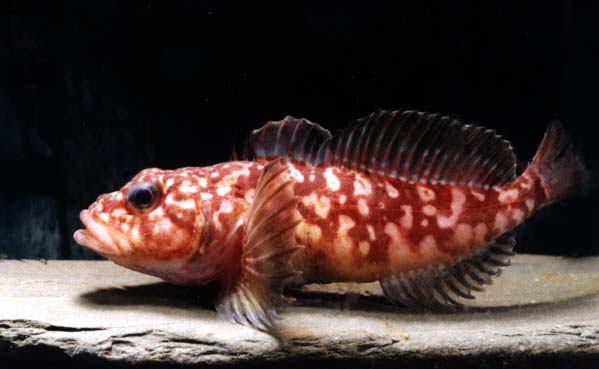
Abyssocottidae: Deepwater Baikal Sculpins
These sculpins are also found in Lake Baikal, but do not have as many exciting characteristics as the previous family. They are not found above 170m in the lake.
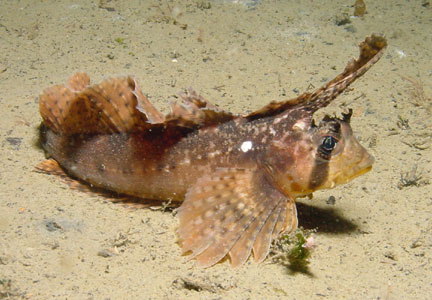
Hemitripteridae: Searavens
The favorite fish of football fans in Baltimore...these fishes are covered with tiny spines. The sailfin sculpin, Nautichthys oculofasciatus, is recognizable by the elongated first four spines of its dorsal fin, giving it a prominent "sail" on its head.
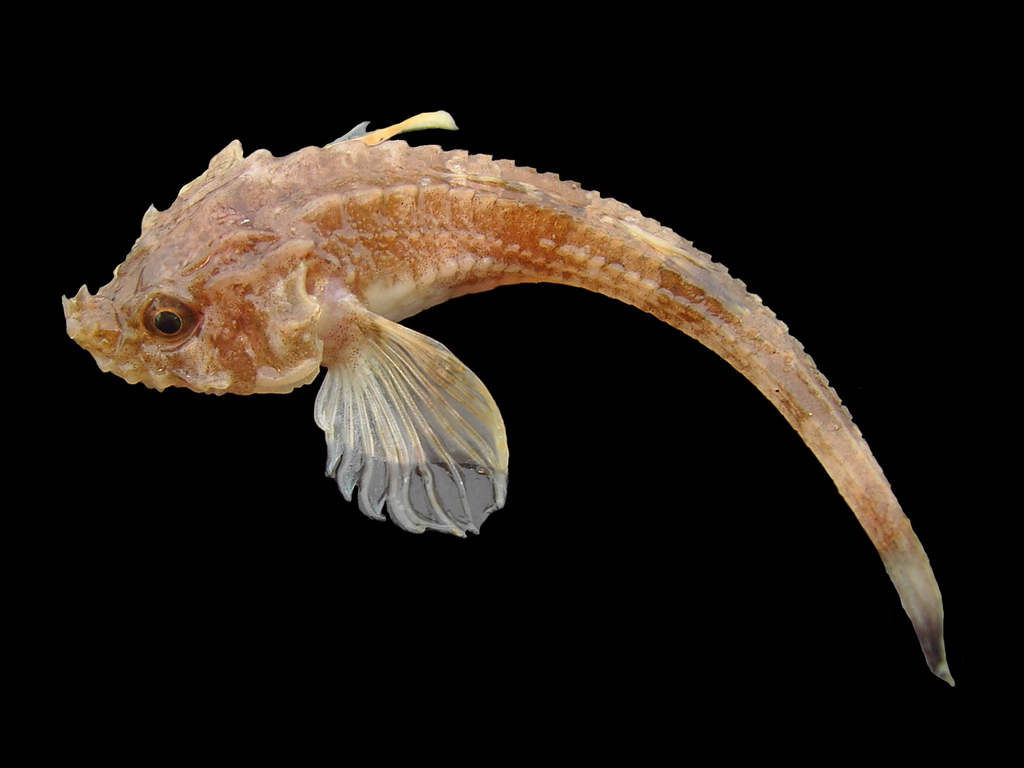
Agonidae: Poachers
These long skinny fishes are covered with bony plates, like fish body armor. They have tiny pelvic fins and lack a swimbladder. Contrary to their common name, they actually prefer their eggs sunny-side up.
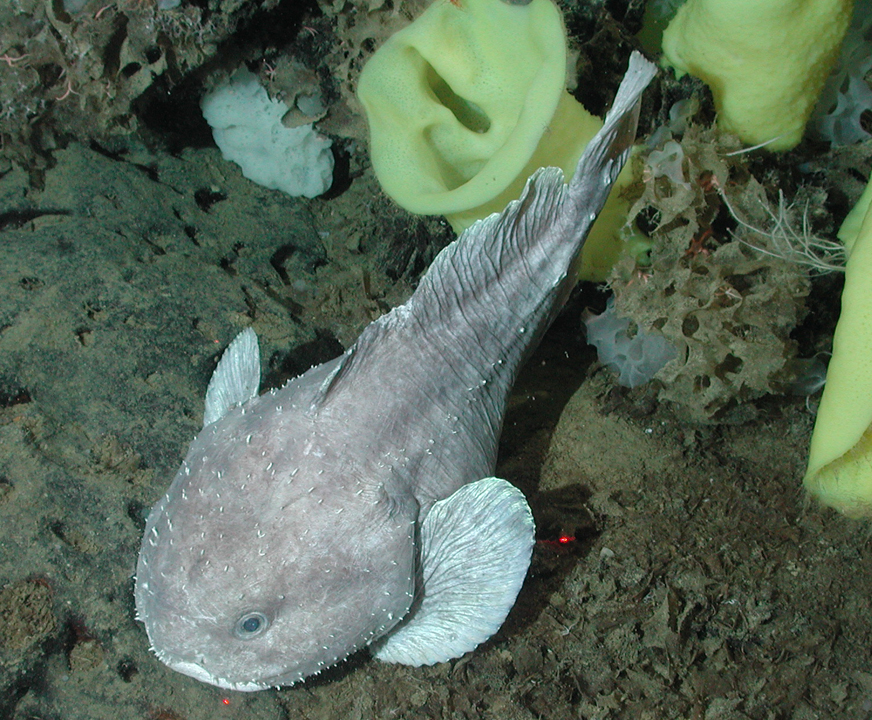
Psychrolutidae: Fathead Sculpins
And you thought you had body image problems? How do you think this fish feels, being called "FATHEAD" all the time? This family has a large head with a tapering body, and lacks scales (though it may have prickles). To make matters worse, this family includes the infamous blobfish, Psychrolutes marcidus. This fish lives deep in the oceans, and only looks blobby when we humans bring it to the surface. Its lack of proper musculoskeletal function actually helps it survive in the abyss, and it looks like a perfectly normal fish at those depths.
Bathylutichthyidae: Antarctic Sculpins
There is only one species, Bathylutichthys taranetzi, and it is known from one specimen. It would have been grouped with the Psychrolutids, but the presence of barbels on the lower jaw deemed it unique enough to deserve its own family.
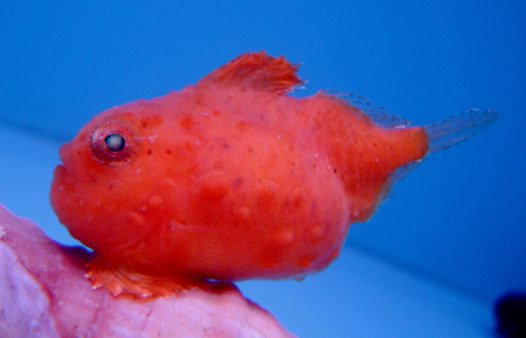
Cyclopteridae: Lumpfishes (Lumpsuckers)
These chubby fishes have a round body covered in small bumps (usually in rows), no lateral line, and the pelvic fins modified into a suction disc. Although not the most attractive fishes, I can state from personal experience that the juveniles are super adorable (and nicknamed "The L'ilest Lumpfish").
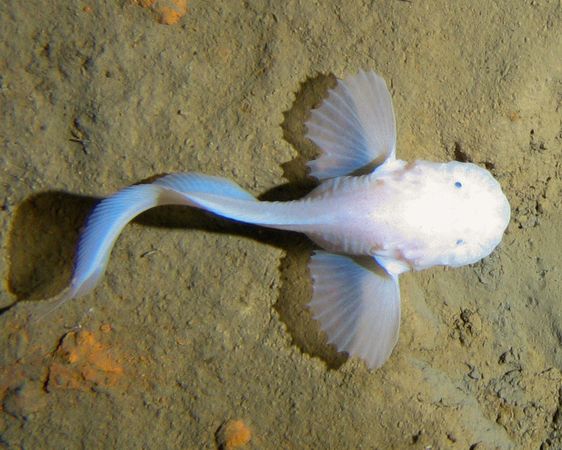
Liparidae: Snailfishes
These fishes have long, scaleless bodies, mushy jellylike skin, and long dorsal and anal fins that may attach to the caudal fin. They have small eyes, but may have prominent sensory pores on their faces and heads. Most species have modified pelvic fins as an adhesive disc, although a couple genera lack this feature.